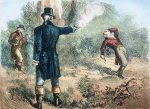By Tweed
The U.S. Constitution is rightly regarded as one of the greatest political documents the world has ever known. It is, after all, written on enormous crinkly parchment with a wonderfully fluid cursive print. It is the basis for many of our laws and a thorough knowledge of this document is a necessity for any serious law student. We begin with a little background.
The U.S. Constitution is written, distinguishing it from the British Constitution which is documented in a group of operettas by Gilbert & Sullivan. Americans decided on a written Constitution because the lack of a tradition of comic opera. Also, some of the founders wanted to show-off their great handwriting.
The story of the adoption of the Constitution is fascinating. After the American Colonists won their independence from Great Britain, they wondered what to do next. Some suggested joining with England. Others suggested forming a reunion committee. Finally, they decided to get down to the business of self-government.
At first, we tried a sort of loose confederation - kind of like a jazz quartet. But over time, it became like free-jazz, and everyone got bored and annoyed.* One of those who felt this sting was George Washington, known as "The Father of His Country," a nickname he acquired after asking Lord Cornwallis at the battle of Yorktown "Lord Cornwallis, sir. Please inform me of your paternity!" Another person anxious to see change was James Madison. Madison greatly desired the adoption of the Constitution so that his nickname, "The Father of the Constitution," would make sense.
At first, delegates from five states gathered in Annapolis, MD to talk about interstate commerce and nibble crab cakes. After a few beers and a half dozen soft-shells, Madison and Alexander Hamilton decided that the only way to get anything done was to have a convention at a city where there were no soft-shell crabs and beer.
A Constitutional Convention was convened in the City of Brotherly Love. No Republicans attended. Though billed as a gathering to goose the existing Articles of Confederation, Convention goers quickly realized that the organizers wanted much more - an entirely new document! This caused an uproar as the delegates figured out that they would likely miss every Phillies day game. Organizers placated the angry mob with free cheese-steaks and commemorative pens.
George Washington was the president of the Convention, primarily because he wanted to be President and it was the only presidency open. This looked great on his resume, but he didn't do all that much. Ben Franklin also attended, but he wanted nothing else than to have young ladies sit on his lap. Despite popular belief, neither Thomas Jefferson nor John Adams attended the Convention. Jefferson was too busy cataloging different types of ivy, and Adams didn't like anyone else who was attending.
The real movers and shakers of the Convention were Madison, Hamilton, Roger Sherman, Edmund Randolph, William Patterson, Henry Lee and Charles Pinckney. Pinckney was particularly brilliant as the Chair of the Refreshments Committee. Lee got off to a grand start until it was determined that he was not a delegate.
Due to a miscommunication in planning, nearly everyone brought their own Plan - Madison brought the Virginia Plan, Patterson brought the New Jersey Plan (which originally included only 1 mall in Passaic), Sherman brought the Connecticut Plan, etc. (Delegates from North Carolina left their plan in an inn near Raleigh but did bring a Scrabble board.)
It was the faux pas that changed the world.
Everyone wanted their own plan to be the adopted plan. Fortunately, some plans, like the Rhode Island Plan, turned out to be nothing more than seating arrangements. Nonetheless, the delegates were forced to negotiate what to finally adopt. This resulted in the Great Compromise: everyone agreed that because of Madison's nickname, his plan should at least form the basis of the plan adopted. Everyone also agreed that because Sherman had traveled so far (and because he bribed delagates with lucrative government contracts), portions of his plan should be adopted as well. Finally, everyone agreed that Franklin could eat as much pudding as he liked as long as he stopped quoting himself so much.
Everyone treated the New Jersey Plan nicely, but nobody really wanted to talk about it.
The delegates struggled with the great issues a nation of states must grapple with - the relative power of the states to the Federal government; the structure of the Federal government, the role of foreshadowing in contemporary novel. All of these issues were superbly handled and are all clearly and plainly settled by the text of the Constitution, so that every Constitutional question can be answered without reference to any other document or other material. Really.
After the convention, the delegates returned to their home states with their "Constitutional Convention" tote bags and "I Attended the Constitutional Convention and All I Got was This Lousy T-Shirt" t-shirts. Madison, Hamilton and John Jay decided that it would be a good idea if the Constitution were actually adopted, and so decided to convince as many people as they could to vote for adoption. They started drafting a series of essays (now known as The Federalist Papers) and threatened to keep writing these essays until the Constitution was adopted. The Federalist Papers so impressed everyone that all of the states ratified the Constitution and, to the relief of nearly everyone, Madison, Hamilton and Jay to stop writing their essays.
And that's how the Constitution was adopted.
* Further, Mr. Livingston of New Jersey hogged all the solos.
Tuesday, December 21, 2004
Subscribe to:
Post Comments (Atom)


No comments:
Post a Comment